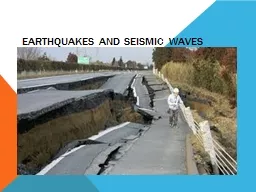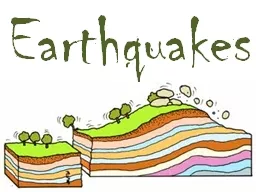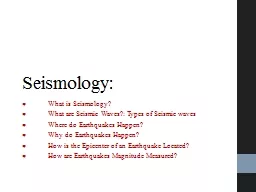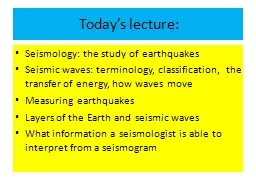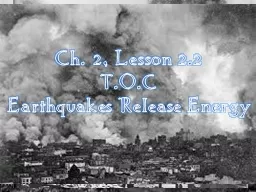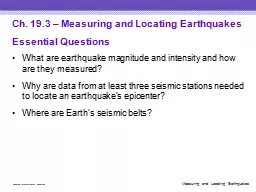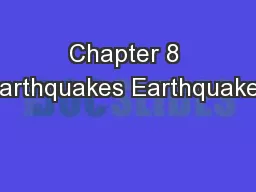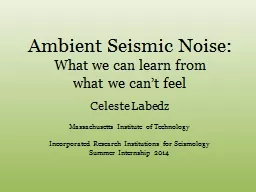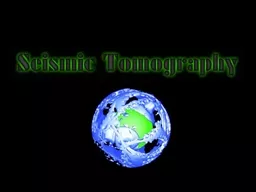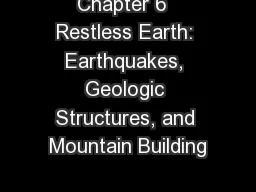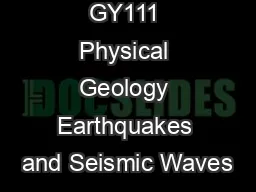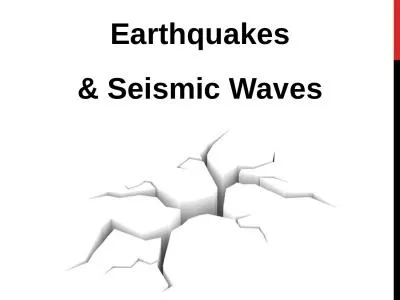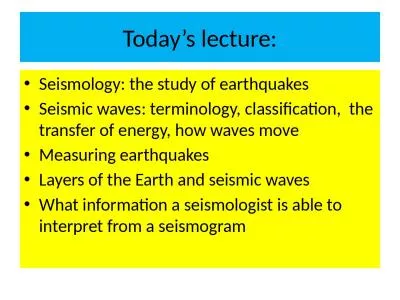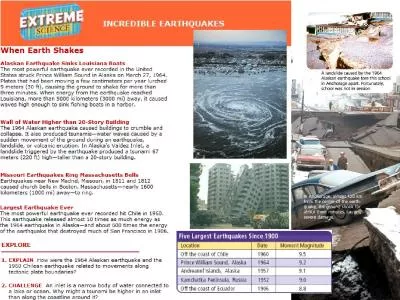PPT-Earthquakes and Seismic Waves
Author : briana-ranney | Published Date : 2017-01-20
Earthquake shaking and trebling that results from the movement of rock beneath Earths surface Plate movement causes earthquakes from stress and faults in Earths
Presentation Embed Code
Download Presentation
Download Presentation The PPT/PDF document "Earthquakes and Seismic Waves" is the property of its rightful owner. Permission is granted to download and print the materials on this website for personal, non-commercial use only, and to display it on your personal computer provided you do not modify the materials and that you retain all copyright notices contained in the materials. By downloading content from our website, you accept the terms of this agreement.
Earthquakes and Seismic Waves: Transcript
Earthquake shaking and trebling that results from the movement of rock beneath Earths surface Plate movement causes earthquakes from stress and faults in Earths crust When the rock breaks earthquakes happen. By. : 10 grade. What is an earthquake ?. Simply, earthquakes are the rumblings, shaking or rolling of the earth's surface. It is usually what happens when two blocks of the earth suddenly slip past one another, or break apart from each other as a result of tension caused by prolonged energy build up. . Deformation. The process of when a rock changes because of stress. Compression. -rocks push together (squeezing). Tension. -rocks pull away from each other (stretching). Rock layers bend when stress is placed on them. But when the stress is placed on rocks, they can reach their elastic limit and break. ● What is Seismology?. ● What are Seismic Waves?: Types of Seismic waves. ● Where do Earthquakes Happen?. ● Why do Earthquakes Happen?. ● How is the Epicenter of an Earthquake Located?. ● How are Earthquakes Magnitude Measured?. Seismology: the study of earthquakes. Seismic waves: terminology, classification, the transfer of energy, how waves move. Measuring earthquakes. Layers of the Earth and seismic waves. What information a seismologist is able to interpret from a seismogram. T.O.C. Earthquakes Release Energy. Energy from Earthquakes Travels through Earth. Rock/pond comparison. . Earthquake energy travels up, down, and to all sides.. Seismic waves. (-. w.w. - vibrations of energy caused by earthquakes. . Essential . Questions. What are earthquake magnitude and intensity and how are they measured?. Why are data from at least three seismic stations needed to locate an earthquake’s epicenter?. Where are Earth’s seismic belts?. Earthquakes result from sudden motions along breaks in Earth’s crust and can affect landforms and societies.. An entire branch of Earth science, called . seismology. , is devoted to studying earthquakes.. what we can’t feel. Celeste Labedz. Massachusetts Institute of Technology. Incorporated Research Institutions for Seismology. Summer Internship 2014. What can ambient seismic. noise give us?. Clues about the inside of the earth. Seismic . Waves. . are shock . waves . given off by earthquakes. . There are 2 types:. 1. . Body Waves. . originate from the . focus. (. F. ). travel . through. . the earth. . They’re used to locate . . What Is an Earthquake?. An . earthquake. is the vibration of Earth produced by the rapid release of energy. Energy released radiates in all directions from its source, the . focus. . Energy is in the form of waves. Earthquake Mechanisms. Brittle Mechanical Model: “stick-slip”. Focal point: 3D point inside the lithosphere where the seismic event occurs. Epicenter: projection of focal point to the map surface . For a quick laugh…. Geologists use 2 terms when discussing the location of an earthquake:. Focus. . = The area beneath Earth’s surface where the rock that is under stress actually breaks.. Epicenter. Seismic waves: terminology, classification, the transfer of energy, how waves move. Measuring earthquakes. Layers of the Earth and seismic waves. What information a seismologist is able to interpret from a seismogram. (Page 51). BEFORE, you learned. • Most earthquakes occur along tectonic plate boundaries . • Different directions of stress cause normal, reverse, and strike-slip faults. NOW, you will learn. • How energy from an earthquake travels through Earth .
Download Document
Here is the link to download the presentation.
"Earthquakes and Seismic Waves"The content belongs to its owner. You may download and print it for personal use, without modification, and keep all copyright notices. By downloading, you agree to these terms.
Related Documents

